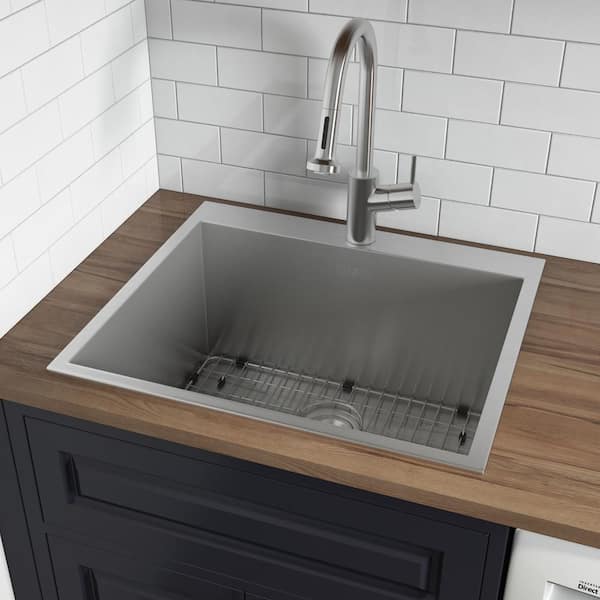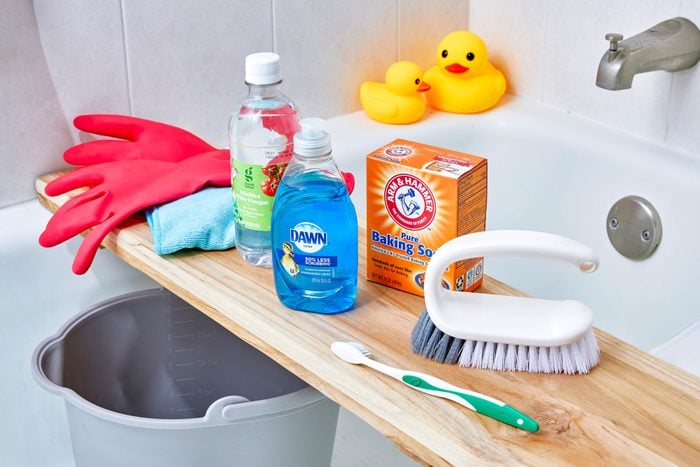Physical Address
304 North Cardinal St.
Dorchester Center, MA 02124
To clean a utility sink, start by removing any debris, scrubbing with a cleaning solution, and rinsing thoroughly. A utility sink is a versatile fixture used for various cleaning tasks in laundry rooms, garages, or workshops.
Over time, these sinks can accumulate dirt, grime, and soap scum, making regular cleaning essential. By following a few simple steps, you can keep your utility sink clean and functioning efficiently. We will discuss how to clean a utility sink effectively using common household items.
By maintaining a clean sink, you can ensure a hygienic space for your cleaning activities and prevent clogs or odors from developing. Let’s dive into the steps for cleaning your utility sink like a pro.

Credit: www.homedepot.com
When it comes to cleaning your utility sink, selecting the right cleaning supplies is crucial to effectively removing dirt and grime. By choosing the appropriate cleaners and tools, you can ensure a thorough and efficient cleaning process.
Select a cleaner based on the material of your utility sink. For porcelain or stainless steel sinks, opt for mild dish soap or vinegar. If dealing with tough stains, use a non-abrasive cleaner specifically formulated for sinks.
Preparation:
Remove any items around the utility sink to create a clear work space.
Ensure your safety by wearing appropriate protective gear during the cleaning process.
Learn how to effectively clean your utility sink with these basic cleaning steps. Keep your sink looking fresh and sanitary with these easy-to-follow guidelines.
Basic Cleaning Steps Keeping your utility sink clean is essential to maintain a hygienic and organized workspace. By following a few simple steps, you can ensure that your utility sink remains spotless and free from dirt and grime. Below, we outline the basic cleaning steps to help you keep your utility sink in top condition. H3 headings in HTML syntax: “`html
Credit: www.rd.com
To effectively clean a utility sink, start by removing any debris or objects. Then, apply a mixture of mild detergent and warm water to scrub the sink thoroughly. Rinse with clean water and dry with a towel for a deep and sparkling clean.
Deep cleaning your utility sink can be a daunting task, but with the right techniques, it can become a breeze. One of the most common issues you might encounter is stubborn stains and mineral deposits that build up over time. These can make your sink look unsightly and can even affect its functionality. Fortunately, there are a few effective methods you can use to remove these stains and deposits.
If you notice any mineral deposits or rust stains in your utility sink, do not panic. The first step to tackle these pesky marks is to create a homemade cleaning solution. Mix equal parts of white vinegar and water in a spray bottle. The acidic properties of vinegar work wonders in breaking down mineral deposits.
To remove stains, generously spray the cleaning solution on the affected areas and let it sit for a few minutes. Use a soft brush or scrubbing pad to gently scrub the stains away. Be sure to cover all corners and crevices of the sink for a thorough clean. Rinse the sink with water, and you’ll be amazed at the difference.
Removing stains and deposits is just the first step in deep cleaning your utility sink. The next crucial step is to give it a good scrub to eliminate any grime or dirt that may have accumulated over time. Scrubbing the sink not only improves its appearance but also ensures a hygienic environment for your cleaning tasks.
To effectively scrub your sink, start by rinsing it with warm water to loosen any loose debris. Next, sprinkle a mild abrasive cleaner, such as baking soda, over the surface of the sink. Using a damp sponge or cloth, scrub the sink in circular motions, paying extra attention to the corners and edges. The gentle abrasive action of baking soda helps remove stains and grime without scratching the sink’s surface.
After scrubbing, rinse the sink thoroughly with water and dry it with a clean cloth to prevent water spots or streaks. If necessary, go over the sink with a stainless steel polish to restore its shine.
Deep cleaning your utility sink is an essential part of maintaining a clean and functional space. By following these simple steps and using the right cleaning products, you can ensure that your sink stays spotless and pristine for all your household tasks.
When it comes to cleaning your utility sink, it’s important not to overlook the faucet and drain. These parts are often overlooked in cleaning routines, but they can accumulate dirt, grime, and bacteria over time. In this section, we will guide you through the process of cleaning the faucet and clearing the drain to keep your utility sink hygienic and in good working condition.
Start by gently wiping the faucet with a soft cloth dampened with warm, soapy water. This will help remove any surface dirt or residue. Be sure to pay attention to hard-to-reach areas such as the base of the faucet and around the handles.
For tough stains or mineral buildup, create a paste using one part baking soda and two parts water. Apply the paste to the affected areas and let it sit for a few minutes. Then, scrub gently using a soft toothbrush or sponge. Rinse thoroughly with warm water and dry with a clean cloth.
To restore the shine to your faucet, you can use a solution of equal parts water and white vinegar. Soak a cloth in the solution and wipe down the faucet, paying attention to any areas with spots or limescale. Rinse with warm water and dry with a clean cloth.
Over time, debris, soap scum, and other residue can accumulate in your utility sink’s drain, leading to clogs or unpleasant odors. Clearing the drain regularly is essential to maintain proper drainage and prevent any issues.
Start by removing any visible debris from the drain opening, such as hair or food particles. You can use a pair of tweezers or a small brush to carefully remove these items. Dispose of them properly to avoid further clogging.
Next, flush the drain with hot water for a few minutes to remove any remaining debris. If you notice slow drainage or a foul smell, you can use a mixture of baking soda and vinegar to help unclog and freshen the drain. Pour one cup of baking soda down the drain, followed by one cup of vinegar. Let the mixture sit for a few minutes, then flush with hot water.
To prevent future clogs, consider using a drain cover or strainer to catch hair and other large particles before they can go down the drain. This simple step can save you from headaches and costly plumbing repairs in the long run.
Once the main cleaning is done, it’s time for the final rinse and dry. This step ensures that the utility sink and the surrounding area are left clean and free from any cleaning residue or water spots.
After scrubbing the sink thoroughly, use clean water from the faucet or a spray bottle to rinse away any remaining soap or cleaner. Make sure to reach all the nooks and corners of the sink to ensure complete removal of the cleaning solution. This step helps to prevent any build-up of residue that may occur if the cleaning solution is left on the surface.
After rinsing, use a clean and dry microfiber cloth or towel to thoroughly dry the sink and the surrounding area. Ensure that you also wipe down the faucet, handles, and any other fixtures to prevent water spots and streaks. This step helps to leave the sink sparkling clean and free from any watermarks.
Maintaining a clean sink is essential to ensure a hygienic and organized workspace. Regular maintenance helps in preventing stubborn buildup and maintaining the overall functionality of your utility sink.
When you encounter issues with your utility sink, troubleshooting can help you get it back to its pristine state. Here are tips to address common problems:
Dealing with Lingering OdorsOdors in the utility sink can be unpleasant, but they can be tackled with a few simple steps:
Stubborn stains can diminish the appearance of your utility sink, but they aren’t impossible to remove:

Credit: www.amazon.com
Keeping your utility sink clean is essential for maintaining a hygienic and organized space. By following the simple steps outlined in this blog post, you can ensure that your utility sink remains free from grime and odors. Regular cleaning and maintenance will prolong the lifespan of your sink and contribute to a healthier environment in your home.